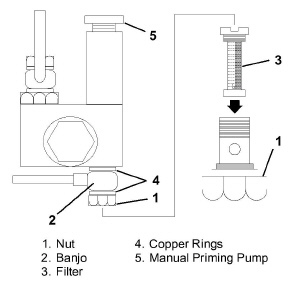
Section 5
Service And Preventative Maintenance
This section covers service for the generator set and general engine service. Refer to the Kubota engine workshop manual, Section 2.1, for additional engine servicing.
Beware of moving V-belt and belt driven components.
5.2PREVENTATIVE MAINTENANCE SCHEDULE
A tabular listing of the recommended preventative maintenance activities and schedule is provided in Table 5–1.
When replacing the battery, determine whether the unit was supplied with a mat in the battery tray. If so equipped, the mat must also be replaced.
5.4ENGINE SERVICE AND COMPONENTS
The unit is equipped with a mechanical fuel lift pump mounted on the engine next to the injection pump. The fuel system is a closed circuit which will require bleeding if loss of fuel has occurred. To fill and bleed the system, do the following:
1.Turn fuel bleed valve (Red, see Figure 2.4) counterclockwise until fully opened.
2.Turn the top of the hand priming pump (see Figure 5.1) counter-clockwise to unlock it, and then hand pump the manual plunger until a positive pressure (resistance) is felt. This will indicate fuel flow.
3.Depress and turn the top of the hand priming pump clockwise to lock in place.
4.Start engine. (Refer to Section 3.5.)
5.When engine is running properly, turn fuel bleed valve clockwise until fully closed.
5.4.2Servicing Fuel Pump Internal Filter
Foreign particles in the fuel and wax (which results from using the wrong grade or untreated fuel in cold weather) may plug or restrict the internal fuel filter and the engine will loose capacity. The filter must be cleaned on a regular schedule.Quality of the fuel will affect the filter cleaning schedule (refer to Section 5.2).
1.Turn nut (item 1) counter-clockwise to loosen and remove.
2.Remove banjo fitting (item 2) and let it hang loose, making sure to keep copper rings (item 4) for replacement.
3.Turn filter (item 3) counter-clockwise and remove. Check and clean.
4.To install, reverse steps 1 through 3.
Figure 5.1 Mechanical Fuel Pump

The fuel flow filter is located on the generator set unidrive assembly (see Figure 2.2).
To replace the fuel filter, loosen and remove the filter housing. Lightly oil new gasket with lube oil and replace the filter.
If the generator set is equipped with the fuel filter bowl assembly, when replacing the fuel filter, a new fuel filter O-ring should be oiled and replaced, and then the clear bowl should also be tightened to 18 ft-lbs.
5.4.4In−Line Fuel Strainer (Option)
Loosen bowl by turning counter-clockwise. To renew, remove in-line fuel strainer, check and clean, and replace.
To ensure adequate cooling, the radiator must be clean, externally and internally. To service the cooling system, do the following:
1.Remove all foreign material from the radiator coil by reversing the normal air flow. Compressed air or water may be used as a cleaning agent. It may be necessary to use warm water mixed with any good commercial dishwasher detergent. Rinse coil(s) with fresh water if a detergent is used.
2.Drain coolant completely by opening drain cock and removing radiator cap.
Never pour cold water into a hot engine.
3.Close drain cock and fill system with clean, untreated water to which between 3% and 5% of an alkaline base radiator cleaner should be added; six ounces (dry) = 151 grams to one gallon (3.8 liter) of water.
4.Run engine 6 to 12 hours and drain system while warm. Rinse system three times after it has cooled down. Refill system with water.
Use only ethylene glycol, anti-freeze (with inhibitors) in system. Use of glycol by itself will damage the cooling system (Refer to Section 2.10.k).
5.Run engine to operating temperature. Drain system again and fill with treated water/anti-freeze (see above Caution note).
The oil filter is located near the radiator fan (see Figure 2.5).
1.After warming up the engine, stop engine, remove drain plug from oil reservoir and drain engine lube oil.
2.Replace filters. Lightly oil gasket on filter before installing.
3.Add lube oil (Refer to Section 2.10.f).
4.Warm up engine and check for leaks.
5.4.7Servicing Low Oil Pressure Switch
1.Remove harness connection from low oil pressure switch (LOP).
2.Remove pressure switch from engine.
3.Apply Teflon thread sealer to threads of new low oil pressure switch.
4.Install new low oil pressure switch.
5.Reconnect harness connection to low oil pressure switch.
The engine speed is electronically controlled. DO NOT ATTEMPT TO ADJUST ENGINE SPEED.
5.4.9Replacing the Engine Speed Sensor
1.Disconnect the plug to the sensor.
2.Remove the bolt securing the sensor to the housing.
3.Remove the sensor from the housing.
4.Clean the recess in the housing to ensure that the sensor seats properly when re-installed.
5.Re-install the sensor, replace the securing bolt and connect the plug to the sensor.
Beware of moving poly V-belt and belt driven components.
Beware of pinch points.
A frayed, cracked or worn poly V-belt must be replaced. After installing a new belt, check the adjustment after running the unit for three or four hours. This will allow for the initial stretch, which is common on new belts. Once this initial stretch has taken place, the belt should be checked at regular intervals.
The poly V-belt is driven by a sheave on the engine crankshaft. Its two functions are: (1) to drive the radiator fan and (2) to drive the water pump.
To replace the poly V-belt, perform the following steps:
1.Using the proper size socket, slowly rotate the crank on the crank pulley nut. At the same time, use a flat, blunt object to guide the belt off the crank pulley towards radiator. Be careful not to damage grooves on the pulley.
2.Replace the poly V-Belt by positioning the belt on the water pump pulley, and while rotating the engine (as in step 1.), use a flat, blunt object to guide the belt onto the crank pulley. Be careful not to damage grooves on the pulley or belt.
The dry element engine air cleaner uses a dry element filter (see Figure 5.2) to filter the engine intake air. The oil bath air cleaner option uses an oil cup instead of the dry element filter (see Figure 5.3).
The engine air cleaner should be inspected regularly for leaks, (see Figure 2.1). A damaged air cleaner or hose can seriously affect the performance and life of the engine. The air cleaner is designed to effectively remove contaminants from the air stream entering the engine. An excessive accumulation of contaminants in the air cleaner will impair its operation. Therefore, a service schedule must be set up and followed.
1.Check all connections for mechanical tightness. Be sure the air cleaner outlet pipe is not fractured.
2.In case of leakage, if adjustment does not correct the problem, replace necessary parts or gaskets. Swollen or distorted gaskets must always be replaced.
The air filter indicator, used with the dry element filter, is mounted on the unit frame and connected to the engine air intake. Its function is to indicate when the air cleaner dry element needs to be replaced. In operation: When a plugged air cleaner decreases intake manifold pressure to 500 mm (20”) WG, the indicator moves to the red line. The air cleaner element should be replaced and the indicator reset by pressing the reset button.
b. Air Cleaner, Dry Element Service
1.Stop the engine and open the cap clamps (see Figure 5.2) to remove air cleaner bottom cap.
2.Remove the air filter element from the air cleaner body.
3.Install the new element, secure the bottom cap with the cap clamps.
Figure 5.2 Air Cleaner, Dry Element
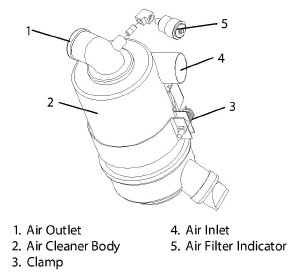
When reassembling the Air Cleaner, make sure the Clamp Bolt faces out, away from the fuel filter. If the Clamp Bolt is assembled facing in, it can contact the fuel filter and cause excessive wear.
c. Air Cleaner, Oil Bath Service
The oil cup should be inspected during pretrip, before each trip. Never allow more than 1/2 inch (12.7 mm) of dirt deposit in the cup. More than 1/2 inch accumulation could result in oil and dirt carrying over into the engine, causing accelerated engine wear. Heavily contaminated oil will not allow the air cleaner to function properly.
Always cover the engine inlet tube while the air cleaner is being serviced.
1.Stop the engine and remove the oil cup from the air cleaner. Dispose of the oil in an environmentally safe manner.
2.Remove the inner oil cup from the oil cup and clean both cups.
3.Reassemble and fill both oil cups to the indicated level with oil specified in Section 2.10.
Do not underfill or overfill the oil bath cups. Overfilling cups causes loss of capacity; underfilling cups causes lack of filtering efficiency.
Figure 5.3 Air Cleaner, Oil Bath
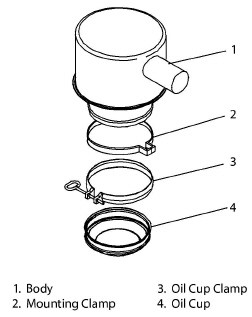
The air cleaner body should be inspected each time the oil cup is serviced. If there is any sign of contaminant buildup or plugging, the air cleaner body should be removed and back flushed.
At least once a year, or at regular engine service intervals, remove the entire air cleaner and perform the following cleaning procedure:
1.Remove oil cup. Check and clean center tube.
Do not use gasoline to clean air cleaner parts.
2.Pump solvent through the air outlet with sufficient force and volume to produce a hard, even stream out of the bottom of the body assembly. Reverse flush until all foreign material is removed.
5.4.12Engine Crankcase Breather
The engine uses a closed type breather with the breather line attached to the cylinder head cover (see Figure 5.4). It is not necessary to disassemble valve style elements for cleaning. However, the bleed hole should be checked to ensure it is free of obstruction. Check once a year or at every 4,000 hours maintenance interval, whichever comes first.
Figure 5.4 Engine Crankcase Breather
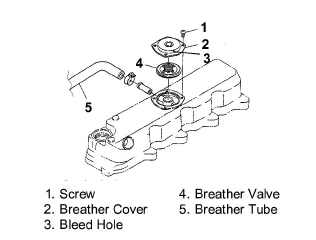
1.Disconnect the lead from the heater terminal (1).
2.Measure the resistance between the heater positive terminal (1) and the heater body (2).
3.If the resistance is infinity or significantly different than the specification, resistance (cold) 0.3 ohms, replace the heater.
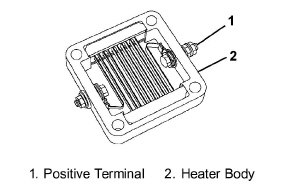
1.Remove harness connection from heater.
2.Remove intake transition mounting hardware.
3.Remove intake transition, heater and both gaskets.
4.Clean old gasket material off the transition and manifold mounting services.
5.Install new heater with a new gasket on either side.
6.Assemble transition to heater and torque mounting hardware (refer to engine manual for torque values).
7.Reconnect harness to heater connection point.
8.Coat stud on heater with protective coating.
1.Remove control box cover.
2.Remove all connections going to heater switch (HS).
3.Remove heater switch from control box.
4.Install new heater switch.
5.Reconnect wire harness connections to switch.
6.Confirm wires are connected to correct terminals.
7.Reinstall control box cover.
5.5SERVICING THE ALTERNATING CURRENT GENERATOR
5.5.1Preventative Maintenance and Operating Precautions
Costly repairs and down time can usually be prevented by operating electrical equipment under conditions that are compatible with those under which the equipment was designed. Follow the instructions outlined below to insure maximum efficiency of the electrical equipment.
a. Cooling
Keep all cooling parts clean. DO NOT EXCEED TEMPERATURE RISE OF 80°C (176°F) ABOVE A 40C (104F) AMBIENT. This ensures that the NEMA Class “F” insulation will not be damaged. DO NOT EXCEED RATED LOAD except as specified for the equipment. OPERATE GENERATOR AT RATED SPEED. Failure to operate generators at rated load or speed will cause overheating and possible damage to windings due to over voltage or current.
b. Generator Windings (Drying)
Do not direct water or steam into the generator openings. Do not allow any soap and water solutions to enter the alternator.
High voltage (dielectric) testing must not be performed to the machine without first observing NEMA rules. The insulation of this generator winding may be safely checked by using a megger. A high megger reading indicates good insulation.
Generators that have been in transit, recently steam cleaned or in storage for long periods may be subjected to extreme temperature and moisture changes. This can cause excessive condensation, and the generator windings should be thoroughly dried out before bringing the generator up to full nameplate voltage. If this precaution is not taken, serious damage to the generator can result. The following steps should be taken to effectively dry the generator windings:
1.Dry windings by placing generator in drying oven or hot room, or dry with warm air blower directed through windings.
2.If the generator has been operated and is being placed into storage for any period of time, a P.D. George #11127 type air-dry fungus resistant varnish should be applied.
The finest insulation job can be very quickly broken down by carelessly applying high voltage to windings in a moisture saturated condition. Failure to follow these guidelines could easily cause a breakdown, making it necessary to return the generator to the factory for repair.
If a rotor becomes defective, it should be returned to the factory with full nameplate data. To repair a rotor, the special tooling and technique of the factory are necessary and essential. Should a failure occur, Carrier Transicold should be notified immediately and steps will be taken to return the generator for service.
5.5.2Generator Repair/Test Procedures
a. Restoring Residual Magnetism
The direct current (DC) necessary to magnetize the alternator field is obtained from the exciter. Initially, upon starting the generator, current flow and voltage are induced into the exciter armature by the magnetic lines of force set up by the residual magnetism of the exciter field poles.
Residual magnetism of the exciter field poles may be lost or weakened by a strong neutralizing magnetic field from any source, or if the generator is not operated for a long period of time.
Should the generator fail to build up voltage after being disassembled for any reason, a momentary short-circuit of any two generator leads (L1, L2 and L3) while generator is running should be sufficient to correct this condition.
When trying to restore residual magnetism, be sure to wear safety glasses and non-conductive gloves. Use an insulated 12 gauge (or higher) jumper wire. Cut off all but a few strands from both ends of the jumper wire to help prevent fusing.
As an alternate method, apply either an alternating current or a direct current voltage of approximately 20 volts to any two generator leads (L1, L2 and L3) while generator is running. Do not make a positive connection, but rather touch the leads together until the generator voltage begins to rise, then remove. Insert a 30 ampere fuse into the circuit to prevent any damage in case the build-up voltage is not removed quickly enough. Reflash field if generator output voltage does not build up.
b. Winding Insulation Testing
Continuity test results for the stator winding tests are provided in the following table:
Wire Pair |
Ohm* |
Wire Pair |
Ohm* |
Wire Pair |
Ohm* |
|---|---|---|---|---|---|
T10-T1 |
I |
T1-T8 |
I |
T4-T5 |
I |
T10-T2 |
I |
T1-T9 |
I |
T4-T6 |
I |
T10-T3 |
I |
T2-T3 |
I |
T4-T7 |
I |
T10-T4 |
I |
T2-T4 |
I |
T4-T8 |
I |
T10-T5 |
I |
T2-T5 |
0 |
T4-T9 |
I |
T10-T6 |
I |
T2-T6 |
I |
T5-T6 |
I |
T10-T7 |
0 |
T2-T7 |
I |
T5-T7 |
I |
T10-T8 |
0 |
T2-T8 |
I |
T5-T8 |
I |
T10-T9 |
0 |
T2-T9 |
I |
T5-T9 |
I |
T1-T2 |
I |
T3-T4 |
I |
T6-T7 |
I |
T1-T3 |
I |
T3-T5 |
I |
T6-T8 |
I |
T1-T4 |
0 |
T3-T6 |
0 |
T6-T9 |
I |
T1-T5 |
I |
T3-T7 |
I |
T7-T8 |
0 |
T1-T6 |
I |
T3-T8 |
I |
T7-T9 |
0 |
T1-T7 |
I |
T3-T9 |
I |
T8-T9 |
0 |
* 0 = no resistance (closed circuit) & I = infinite resistance (open circuit) |
|||||
c. Diode Testing
The rectifier diode assemblies can be tested, and if damaged, replaced. Over current, over voltage, over speed, or reverse currents can damage the assembly or diodes. To remove the diode assemblies and perform diode testing, do the following:
1.Remove the bearing cover by removing the four bolts (see Figure 5.7). Both the bearing and diode assemblies will be visible.
2.Mark and disconnect the alternator rotor wires at the rectifier screw terminals. Note that the terminals are marked with red paint for the forward diode assembly and black for the reverse diode assembly. Mark and disconnect the exciter leads from the double spade terminals (see Figure 5.6).
3.Remove the two cap screws that secure each diode assembly to the exciter. Once this procedure is complete, the diode assemblies are free for removal.
4.A forward diode should have a low resistance when the + of an ohm meter is connected to the exciter rotor lead connection (anode) and the - to the diode bridge (cathode), and a high resistance when the polarity of the ohmmeter is reversed.
5.A reverse diode should have a high resistance when the + of an ohm meter is connected to the exciter rotor lead connection (anode) and the - to the diode bridge (cathode), and a low resistance when the polarity of the ohmmeter is reversed.
6.If both resistances are high or both are low, the diode is defective and the diode assembly should be replaced.
Figure 5.6 A-C Generator Rectifier Assembly
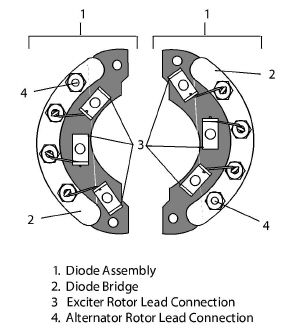
Factory lubricated shielded bearings will normally provide years of trouble-free service when operated under normal conditions. Excessive bearing load and adverse environment conditions will greatly shorten bearing life. To remove the bearings, do the following:
1.Remove bearing cover and mylar gasket. (See Figure 5.7).
2.Remove bearing with a bearing or wheel puller.
3.Install new bearing. Ball bearings are pre-lubricated and require no additional lubrication for the life of the bearing.
4.Coat mating surface of bearing cover flange with anti-corrosion compound (Tef-Gel, Carrier Part Number 02-00083-00).
5.Replace bearing cover and mylar gasket.
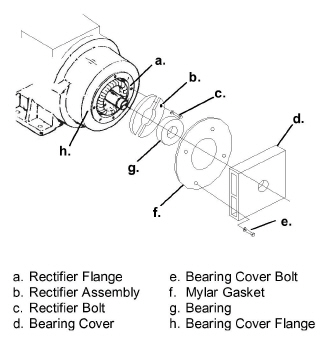
5.5.4Generator Removal and Installation
a. Removing the Generator
1.Remove covers and ground wire from frame of generator set.
2.Remove connection box cover and disconnect power leads.
3.Remove control box mounting screws from the generator mount and the battery mounting bracket.
4.Disconnect air filter from battery mounting bracket.
5.Remove battery and battery box.
6.Remove battery charger shield.
7.Remove battery mounting bracket from the top of the generator.
8.Remove screen cover and generator exhaust baffle from coupling end of generator.
9.Remove the 8mm hex head bolts and washers securing the generator drive disc to the engine flywheel. Turn bolts counter-clockwise with offset wrench to start, then use flexible shaft and socket assembly for removal of bolts.
10.Remove the 3/8 inch hex head capscrews and washers that secure generator frame to engine flywheel housing.
11.Remove four 5/8 inch bolts that secure the generator mounting feet to the shock mount bracket, then remove generator.
b. Installing the Generator
For torque values refer to Section 5.7.
The generator is a single bearing type, which means the shaft end of the rotor floats. Before installing the generator, rotate shaft and check if bearing rotates.
1.Brush anti-seize lubricant (lube-plate) on the face of flywheel.
2.Move generator into position and line up with the holes on housing and flywheel. If required, turn crankshaft to align threaded holes in flywheel with generator drive disc mounting holes.
The rotor should not be pulled out from the alternator more than 0.75 inches. Damage to the bearing and windings may result.
3.Start the 8mm bolts (by hand) through the disc plate and into the flywheel. Once alignment is made torque the six bolts.
4.Secure two of the housing bolts (3/8 inch) on the top and bottom of the generator housing to draw the mating flanges together.
5.Secure the remaining bolts and washers (3/8 inch) and torque bolts in a staggered pattern.
6.Install and torque generator mounting bracket bolts (5/8 inch). Install screen cover, battery mounting bracket, battery charger shield, battery box, battery, power leads, ground wiring and generator cover. Install new gasket when installing generator connection box cover. Reconnect air filter to battery mounting bracket.
5.6GENERAL GENERATOR SET MAINTENANCE
5.6.1Maintenance Of Painted Surfaces
The unit is protected against the corrosive atmosphere in which it normally operates by a special paint system. However, if the paint system is damaged, the base metal can corrode. If the paint system is scratched or damaged, do the following:
1.Clean area to bare metal using a wire brush, emery paper or equivalent cleaning method.
2.Immediately following cleaning, spray or brush on a zinc rich primer.
3.After the primer has dried, spray or brush on finish coat of paint to match original unit color.
5.6.2Checking and Replacing Shockmounts
a. Replacement Criteria
Continued operation with failed shockmounts may result in engine or generator damage.
When a shockmount has been cut, split, abraded or has flared due to normal deterioration, it must be replaced. Damage to the mounts may not be visible when installed and under load from the component. To correctly inspect shockmounts, they must be removed.
b. Engine Shockmount Replacement
For torque values refer to Section 5.7.
1.Use the two lift eyes to lift and support the engine.
2.Remove snubber hardware as shown in Figure 5.8.
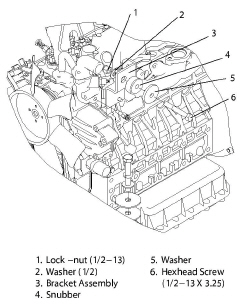
3.Remove all hardware as shown in Figure 5.9.
4.Raise the engine just enough to remove the shockmounts (item 5).
5.Inspect shockmounts and replace if required.
6.Lower the engine enough to assemble hardware as shown and torque per Section 5.7.
7.Replace snubber hardware (Figure 5.8).
8.Remove chains from the lift eyes.
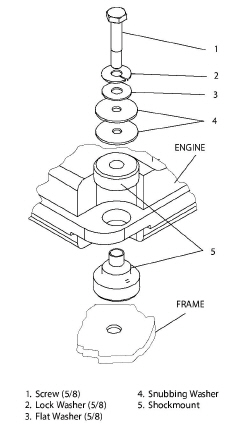
c. Generator Shockmount Replacement
1.Use the two lift eyes to lift and support the engine.
2.Remove snubber hardware as shown in Figure 5.8.
3.Remove shockmount hardware, items 5 through 12, Figure 5.10.
4.Raise the generator just enough to remove the shockmounts (item 7).
5.Inspect and if required, install new shockmounts.
6.Lower the engine enough to assemble hardware as shown and torque. Refer to Section 5.7 for torque values.
7.Replace snubber hardware (Figure 5.8).
8.Remove chains from the lift eyes.
Figure 5.10 Generator Shockmounts
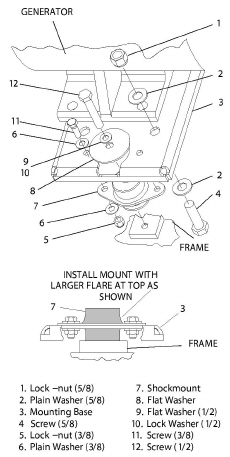
5.7UNIDRIVE TORQUE REQUIREMENTS
Extensive damage may occur if the proper hardware is not used and/or proper procedures are not followed when working with the unidrive assembly. Periodic inspection of hardware and bolt torque is recommended to ensure the integrity of the unidrive.
Torque value and hardware requirements for unidrive assembly are provided in Figure 5.11.
SST is an abbreviation for 300 Series Corrosion
Resistant Steel.
Loctite #242 or an equivalent product should be used on ALL hardware shown
in Figure
5.11.
Figure 5.11 Unidrive Torque Requirements
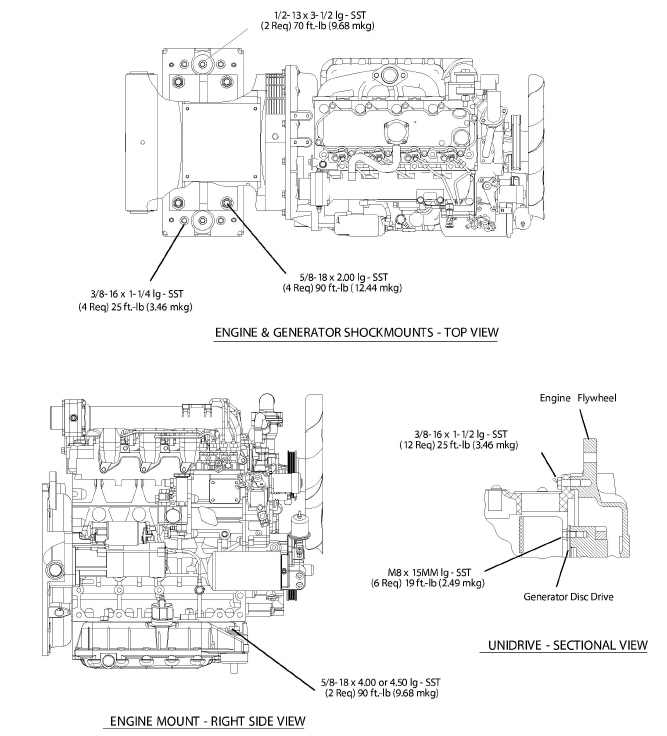
Procedure |
Reference |
Perform at Pre-Trip Inspection |
Every 2000 Hours |
Annually or Every 3000 Hours |
|---|---|---|---|---|
For Pre-Trip inspection, perform items 1 through 13; for “After Start-up” checks, perform items 30 through 34. |
||||
1.Check (in place) engine / generator shock mounts for cracks, cuts, abrasion or flaring |
|
X |
|
|
2.Check engine lubrication, fuel filter, oil lines and connections for leaks |
|
X |
X |
|
3.Check engine lubrication oil level |
2.10.f |
X |
X |
|
4.Ensure poly V-Belt has proper tension; check belt for fraying or cracks |
X |
X |
|
|
5.Check radiator hoses for leaks; check coolant level and 50/50 mixture |
2.10.k |
X |
X |
|
6.Check radiator coil and generator air intake for cleanliness (Clean using compressed air, reversing air flow direction) |
|
X |
X |
|
7.Check air cleaner; clean as necessary |
|
X |
X |
|
8.Drain water from fuel tank sump and fuel filter bowl |
|
X |
X |
|
9.Fill tank with diesel fuel |
2.10.g |
X |
X |
|
10.Check intake heater amperage |
2.10.i |
X |
X |
|
11.Check battery terminals for tightness and cleanliness. Clean and coat terminals with battery terminal sealant |
|
X |
X |
|
12.Check loose electrical connections |
|
X |
X |
|
13.Tighten all hardware (brackets, etc.) |
|
X |
X |
|
14.Change lubricating oil and filter(s)1 |
|
|
X |
|
15.Clean air filter body; check hose connections1 |
|
X |
|
|
16.Change oil bath air filter oil1 |
|
X |
|
|
17.Clean mechanical fuel lift pump internal filter |
|
X |
|
|
18.Tighten engine and generator mounting bolts |
|
X |
|
|
19.Tighten all electrical connections in the control box |
|
|
X |
|
20.Check water pump bearing end play |
See Engine Manual |
|
X |
|
21.Verify operation of engine protective devices |
|
|
|
X |
22.Change fuel filter |
|
|
X |
|
23.Check crankcase breather |
|
|
X |
|
24.Remove and check engine / generator shockmounts for cracks, cuts, splits, abrasion or flaring |
|
|
X |
|
25.Check and, if required, replace poly V-Belt |
|
X |
X |
|
26.Clean and flush coolant system |
|
|
X |
|
27.Check starter condition |
See Engine Manual |
|
|
X |
28.Check engine compression |
See Engine Manual |
|
|
X |
29.Check and adjust injector nozzles |
See Engine Manual |
|
|
X |
After Starting Generator Set, perform the following: |
||||
30.Check total time meter operation (Allow engine to run 10 minutes) |
|
X |
|
|
31.Listen for abnormal bearing noise |
|
X |
|
|
32.Check fuel lines, lube oil lines and filters for leaks |
|
X |
|
|
33.Check exhaust system for leaks |
|
X |
|
|
34.Check
with voltmeter. Generator output should be 490 volts AC +/- 15
volts (engine, 1800 RPM) with a nominal frequency of 60 Hz +/-
0.1% |
|
X |
|
|
NOTE: |
||||